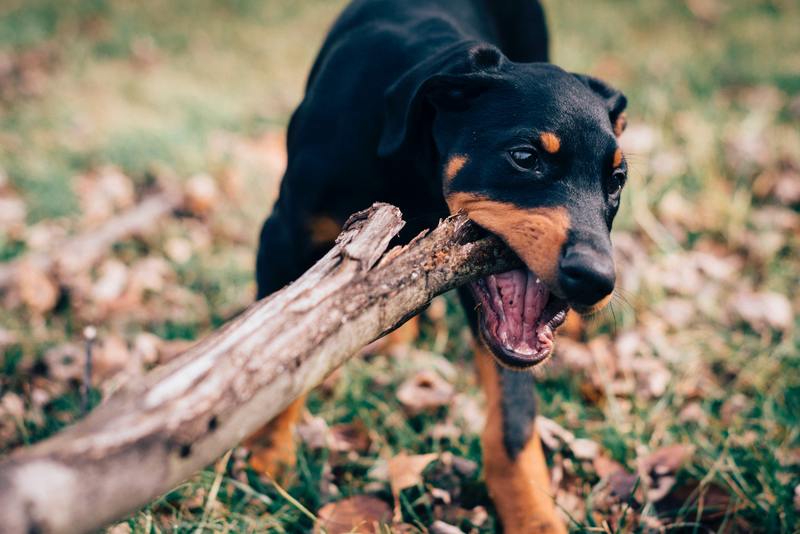Last Updated on September 20, 2023
Dogs are like vacuum cleaners. Anything that they can put in their mouth will most likely be swallowed. Ribbons, toys, coins, marbles, tampons, Legos, bones, sticks, and even rawhide chews became hazardous objects to have at home.
As a pet owner myself, this has cost me hours of panic from the thought that the foreign object he swallowed would get stuck and hurt him. Luckily though (after calling all the saints I know and trying not to go into full panic mode), the objects he swallowed have passed either through his poop or vomit.
However, this may not always be the case. Swallowed objects can cause a potentially dangerous and life-threatening condition called foreign body obstruction. This is a common issue most pet owners deal with when their dogs ingest a foreign object and don’t successfully make it through their intestinal tract. This issue causes pain and discomfort, and sometimes even death.
That said, how long does a foreign object stay in a dog before they pass? What should you do if it doesn’t? Is there anything you can do at home?
Read on to learn how to deal with dogs swallowing foreign objects.
This too shall pass (or not)
Our dog’s digestive tract consists of a long tube from the mouth, down to the esophagus, into the stomach, then to the small intestine, then through the colon, forming a stool, and goes out through the rectum. When your dog ingests anything, it generally takes 10-24 hours to pass through his digestive tract, although this only applies to small objects.
By any chance, your dog ingested objects that are too big, the odds that it would obstruct the stomach or the small intestine is high. Now, you might ask, can he poop it out?
Can my dog poop out the foreign object?
The answer: it depends.
The large size of the canine esophagus allows large objects to be swallowed. But getting past the stomach and small intestine is entirely a different story.
There are muscular “rings” at the entrance and exit of the stomach. Whilst the esophageal muscles forces things to get past the ring at the entrance, there is less force that pushes them towards the exit. You’d be surprised how many objects make it through the stomach, but only a few of them get any further.
But if the stars do align and the foreign body does arrive in the colon, it would have no problem passing on to his stool. However, this is no guarantee that it wouldn’t be painless, especially if it’s a sharp object (like a stick). When this happens, do not pull the object from your pet’s rectum, even if it’s already protruding. If the object is still lodged inside, you can cause damage to the internal tissues if you pull it. Taking him to the vet would be the right choice.
Symptoms of blockage
We can’t monitor our pets 24/7. One minute they are sleeping on the floor next to us, and before we know it, they have something in their mouths. Fast forward to later, they are vomiting and, we don’t know why. If you suspect he swallowed a foreign object, here are the clinical signs you should look out for.
- Vomiting
- Dehydration
- Diarrhea with or without blood
- Drooling
- Increased respiratory rate due to pain
- Lethargy
- Pawing at his mouth
- Loss of appetite
- Abdominal pain
- Evidence of the foreign object (i.e., a bone stuck in the mouth)
The symptoms of intestinal blockage occur within 24 hours. And depending on the symptoms, it will tell you where the foreign body is and how long it has been since she swallowed it.
Timeline of blockage symptoms
If the blockage is in the esophagus, clinical signs will appear right after swallowing the object. The affected dog will excessively lick their lips, swallow a lot, and vomit. His vomit may appear tubular in shape that includes large undigested kibbles. Dehydration is also a sign.
Blockage in the stomach usually means the pylorus is also blocked. The pylorus functions to prevent undigested contents (in this case, the foreign object) from getting to the small intestine. This also prevents digested food from going to the intestine, causing your dog to vomit.
If the foreign object makes it through the esophagus and the stomach, it can still get stuck in his small intestine. A blockage in the small intestine can cause gas to accumulate, resulting in a distended abdomen or swollen belly. Other symptoms also include abdominal pain, fever, and shock. Diarrhea and vomiting may also occur. An untreated obstruction in the small intestine can have serious consequences, even death.
Is there anything I can do to help him pass it through his stool?
Sometimes objects Fido ingests will pass through on their own, even if we don’t think they will. But what should we do while waiting? Can you try to induce vomiting? Unfortunately, resolving the issue of our dogs ingesting a foreign body is out of our expertise. The trouble with trying to induce vomiting on your own is that it can be counterproductive. Inducing vomiting can only be used when your dog does something foolish, like eating a box of chocolate.
In the case of foreign bodies? Not so much.
You have to ask yourself about the possible risks involved when you do. What if it gets lodged in the esophagus on its way back up? You may have successfully move it out of his stomach, but there’s no telling that it won’t get stuck on his esophagus, creating an even more challenging problem to deal with. Fortunately, however, our dogs save us the anxiety and get rid of the object by vomiting it out themselves.
Another method that can help is intravenous fluid therapy. It not only aids in hydration but increases peristalsis or the wave-like contractions in the GI tract that push whatever is in his stomach through. Besides, some foreign bodies may soften in the highly acidic environment of your dog’s stomach. What initially couldn’t pass through will eventually be pooped out.
Don’t wait!
Like everyone else, I understand how we hope our dog would successfully be able to pass it through his stool. But dealing with it earlier can save your pet. An intestinal blockage can cut the blood supply to the tissues in the area. Other than it’s painful, your pet can go into shock due to the toxic enzymes released into the bloodstream. It can eventually tear, creating a hole in the intestinal wall causing various infections.
To prevent this, take him to the vet the moment he is showing signs of obstruction. It’s no brainer that surgical removal of a foreign body in his stomach is better than cutting out an entire segment of his intestine and sewing the ends together.
What happens at the vet?
As previously mentioned, there are different ways of how your veterinarian will remove the foreign object. But first, he has to perform tests to confirm the diagnosis. If he has just ingested the object but otherwise appears healthy, your veterinarian can give him vomit-inducing medications to prevent it from going further down his intestine. If it’s a small enough object to pass through, your vet may consider monitoring his appetite and any clinical signs to ensure that it has successfully passed through.
Your vet may also recommend blood tests and electrolyte imbalances to rule out any secondary complications for your dog. If he is dehydrated, he may be given intravenous fluids. To get a better idea of the foreign body and where it is, your vet will do abdominal x-rays. They will pump air into his stomach or make use of Barium to locate any blockage. An ultrasound may also be used.
For objects stuck in the esophagus, an endoscopy may be done to remove the object.
If the object is found to be blocking the intestines, immediate surgery may be done. The longer the foreign body is left inside, the more dangerous it becomes. Removing it ASAP is crucial for a better outcome.
How to keep your pet safe
One fool-proof way to keep things out of your dog’s mouth and his GI tract is to keep hazardous items out of his reach. Small objects he can easily swallow should be kept away. When it comes to toys and chews, choosing the right size and material is a must. Ones that aren’t easily broken down into smaller pieces are ideal.
If Fido likes to rip toys apart, opt for chew-proof ones. They may be a bit pricey, but it’s a small price to pay for surgically removing it in his stomach in the future. In addition, teaching him the leave it or drop it command can also be life-saving. Use positive reinforcement methods through treats to make it easier for you and your pet.
Lastly, if your dog tends to get himself into lots of trouble, it may be a good idea to invest in dog insurance. Vet bills can be pricey, and pet insurance is a great way to lessen your bills, saving you more money. You can view the best dog insurance here.
Conclusion
If you suspect your dog swallowed a foreign body, please call your vet. There’s a chance he’s going to pass it to his stool, but there is no guarantee. If he exhibits signs of foreign body ingestion, call your vet immediately. He will guide you on the best approach at the moment. Remember, the sooner your dog gets the medical attention he needs, the better are his chances for recovery.










